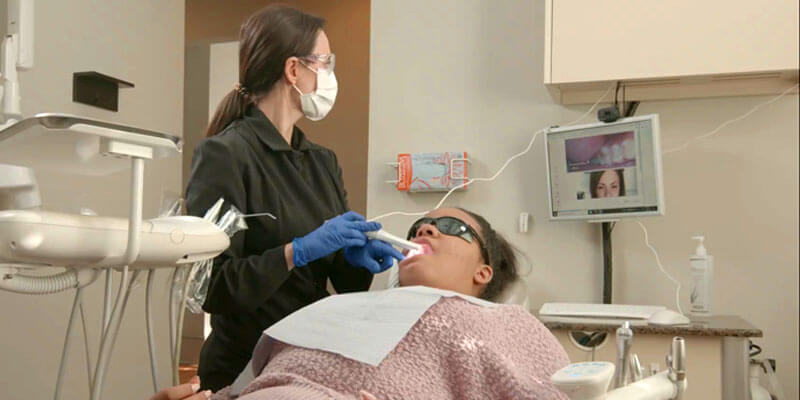
Remote dental care has become a mainstay in 2020, and continues to extend into 2021 and beyond.
The rapid adoption of teledentistry combined with patient satisfaction and demand has created opportunity for dental professionals. Amongst the most searched dentistry jobs is “teledentistry careers”, and with good cause. The popularity of virtual visits is growing amongst the general patient population, the time and costs saving are reflected for both patients and providers.
Teledentistry for Dentists
Enter teledentistry jobs into an internet search engine and you will be met with a variety of opportunities that are hiring for positions to provide virtual care, mostly applicable to dentists. The ability to provide a virtual consult, whether for another employer or via referrals to your own practice, can be enticing. For the semi-retired dentist to the newly licensed dentist, teledentistry provides and avenue to additional income from the safety and comfort of home.
The opportunity to expand a dental practice model is not limited to working for someone else and waiting for patients to find you. Dentists are embracing the many benefits that teledentistry affords their own practice. Using an all-in-one platform, such as TeleDent, enables the dentist to capture the patient populations that may be hesitant to return to in-person care. The typical limited exam takes 30-minutes in your schedule, from barriers to PPE the time and cost for a quick check adds up. With TeleDent a quick evaluation can determine whether the patient needs to be seen in-person for further treatment and how much chair time should be allotted for the needed procedure. The dental office can save on PPE, barriers and room turnover and essentially the chair is available for revenue generating restorative procedures. Did you know the average virtual visit takes only about 15 minutes when there is no room-turnover involved?
Expanding Hygiene Opportunities
Dental hygienists are not to be forgotten in the field of teledentistry. Many hygienists look for alternative practice settings and other opportunities to work in another capacity other than the typical traditional clinical setting. Teledentistry has provided an avenue to expand practice models, allowing hygienists to practice somewhat independently, all while within the state’s practice act.
Mobile dentistry was a steadily growing field prior to the pandemic, with dentists and hygienists dedicated to bringing care to some of the most at-risk patient populations. School based programs screened and provided care to students throughout the country, referring them to a dental office as needed. Hygienists built businesses, bringing care to the residents of long-term care facilities where it could be argued the need is the greatest.
Hygienists are creating their own businesses bringing care to the patient in mobile dentistry vans or mobile equipment into the comfort of the patient’s home. Screening and providing preventative treatment to the patient, capturing images and conducting synchronous and asynchronous virtual visits, referrals and collaboration with the dentist of record ensures the patients is receiving the best care possible.
MouthWatch and TeleDent helps mobile programs
MouthWatch recognizes the struggles and perseverance that mobile dentistry providers have dealt with during the pandemic. As mobile programs begin to resume operations and dentists and hygienists move forward to provide care utilizing teledentistry, we encourage you to apply for the TeleDent Mobile Dentistry Accelerator Award .
The adoption and Practice Acts surrounding teledentistry vary widely depending on the state you are located. At MouthWatch we often hear “Can I use teledentistry in my state?” The short answer is that it depends on your state, your license type and in what manner you will be providing virtual care. The range varies from very limited teledentistry to more progressive states. The COVID-19 pandemic put the world on alert and forced dentistry to adapt, with the adoption of teledentistry and reimbursement greatly accelerated. Many states are clarifying their Dental Practice Act to include teledentistry, and as a result the third party payers are providing reimbursement for the D9995 (synchronous) and D9996 (asynchronous) CDT codes.
California Recognizes Teledentistry Benefits
California is known to be a progressive state when it comes to dentistry and allowances, and teledentistry is no different. Like many states throughout the country, they have recognized the benefit teledentistry brings to some of the most “at-risk” populations. This may include providing access to care at sites including schools, head-start programs, community clinics, long-term care facilities and more. There are an estimated 11 million people in California who live in healthcare shortage areas. Of those, over 6 million people are in areas without access to basic primary medical care. The use of telehealth and teledentistry is bringing care to this population.
Collaborative Practice
California is amongst the leaders allowing a licensed RDHAP to practice as either an employee or sole proprietor to provide a full range of dental hygiene services. The hygienist must enter into a collaborative relationship with a dentist to ensure the patient has a dentist evaluation within 18 months. Using teledentistry as part of collaborative practice makes compliance easy and can streamline the necessary restorative care when the dentist is able to provide a quick evaluations via teledentistry.
Teledentistry Adoption
The Governor signed into law A.B. 1174, which adds teledentistry services that do not require a face-to-face contact to be reimbursed by the state’s Medicaid program. The program allows for dental auxiliaries, licensed assistants and hygienists, to expose x-rays and perform basic evaluation techniques to aid the dentist in evaluations. Teledentistry services are not limited to outreach efforts and may occur in the dental office setting.
Teledentistry use does not just apply in the Medicaid setting in California—the widespread adoption and acceptance is seen from small private-practices to large DSO organizations. Use of an all-in-one program such as TeleDent allows dental providers to stay connected to provide the best possible patient care.
